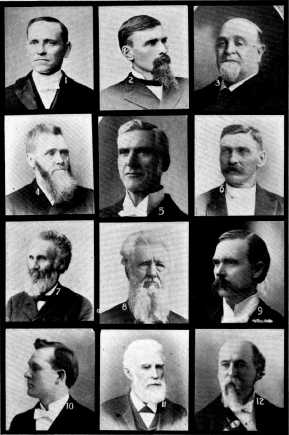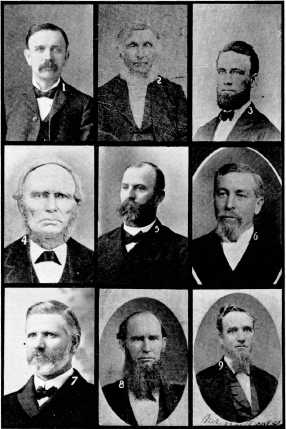
CHAPTER XXII.
FOURTH PERIOD. (1880-1904.)
THUS we
have traced the expansion of the Church until it has covered the
entire area of the State. We have found that organization has kept
pace with the expansion. The little class in the Morris settlement
in Cass County was the first to be organized. But others quickly
followed, necessitating the forming of circuits, stations, and
districts; and, finally, as the population extended, and the area
occupied became greater, the evolution of the four Conferences has
been the natural result of the growth of a live evangelistic
Church.
These Conferences will henceforth have charge of
the territory assigned them, and supervise the further development
and organization of the Church within their bounds. Their work
will have much in common and their progress will be under the same
general laws of spiritual growth, requiring the Divine power of
the Holy Spirit to guide and make effective the consecrated human
agencies.
But while much will be in common, each
Conference will, in subordinate ways, have its own problems to
solve, its own peculiar conditions, which will favor or retard the
progress of the work, and though the workers in each may be
characterized by the same zeal, consecration, and capacity, the
progress in some will perhaps be greater than in others, as
conditions may be more or less favorable. So, if in the farther
tracing of the history in the
405
|
406 |
HISTORY OF NEBRASKA METHODISM. |
different sections of this State we find that some of
these Conferences have made greater progress than others, it will
be attributed to these varying conditions, and not be deemed to
indicate any less fidelity in the workers in any one of the
Conferences. Our Lord Himself found the conditions such at
Nazareth that "He could there do no mighty work."
As a matter of fact it will be found from now on
that the natural conditions in the eastern portion of the State,
occupied by the older Conferences, will be much more favorable
than in the western portion. The experience of the years has made
it plain that while much of the western portion is rich in soil,
it belongs to the semi-arid belt, where the rain fall from year to
year is not sufficient for reliable farming, and the material
growth of that section has not kept pace with the eastern.
However, during this last period, the West Nebraska Conference has
made commendable progress and even the Northwest Conference, where
the conditions have been least favorable, has made some
progress.
This last period will witness the rapid growth
of the large cities. and the establishment of new churches in
eligible locations. Omaha has grown from 30,000 in 1880, to a
little over 100,000 in 1900. The census of 1890 gives the
population as 139,000, but what many suspected at the time was
clearly shown to be the fact by the census of 1900, that the
census of 1890 was padded to the extent of at least 50,000. This
is now acknowledged by all and is regarded by some of the best men
in Omaha as having been a criminal blunder, which has reacted
disastrously. They are now convinced that honesty is the best
policy, even in census matters.

SOME WHO HAVE LED THE HOSTS AS PRESIDING ELDERS.
1. H. HIRST MILLARD. 2. STOKELY D. ROBERTS. 3. R. H. ADAMS. 4. WM. R.
JONES. 5. RICHARD PEARSON. 6. D. F. RODABAUGH. 7. W. A. AMSBARY.
8. J. G. MILLER. 9. ASA C. SLEETH. 10. J. R. GETTYS. 11. GEORGE W.
ELWOOD. 12. W. K. BEANS.
407
|
408 |
HISTORY OF NEBRASKA METHODISM. |
But the increase from 30,000 in 1880 to
100,000 in 1900 is a substantial gain, and has necessitated a
corresponding expansion of our Church. We have seen Seward Street
Church taking the place of the old Eighteenth Street Church, and
South Tenth strengthening its position by building a church in
1880, and a parsonage in 1881. Seward Street has had a healthy
growth under a succession of energetic and able pastors, numbering
such men as Wm. Worley, C. W. Savidge, D. K. Tindal, A. C. Welch,
C. N. Dawson, and Wm. Gorst. It now numbers 444, as compared with
142 reported for Eighteenth Street Church in 1880.
South Tenth Street began the period with
seventy-two and now has one hundred and thirty-one. Thus this
Church has made some progress, but not equal to what we
anticipated. It has been well and faithfully served by such men as
J. W. Stewart, E. G. Fowler, T. C. Clendenning, C. N. Dawson,
Alfred Hodgetts, J. B. Priest, T. C. Webster, G. A. Luce, and the
present pastor, A. L. Mickel. These have all been efficient
pastors, and some most excellent lay workers, such as Luther A.
Harmon and his father, Mrs. N. J. Smith, David Cole, and others,
who were in the Church at the first and were joined by others who
came in later.
In 1886 H. H. Millard, D. D., organized Hanscom
Park Church. This Church occupies one of the very best portions of
the city, and has the field to itself, being far enough away from
any other Methodist Church to prevent any conflict of interest. It
has also been favored by a number of aggressive laymen, prominent
among them being John Dale, a local preacher and business man.
Brother Millard was very successful, and at the
end of
|
HISTORY OF NEBRASKA METHODISM. |
409 |
the year reported a church worth $8,000, and a membership
of ninety-four. It now has a fine church worth $33,500, a
parsonage worth $2,500, and a membership of 352.
The appointment of H. H. Millard to Hanscom Park
Church (which was to be) by Bishop Fowler, in 1886, is a good
illustration of the embarrassment to which a presiding elder is
sometimes subjected. The writer was at that time presiding elder
of the Norfolk District, and had secured Brother Millard from Drew
Theological School, and he having done two years of excellent work
at Wisner, I wished very much to keep him. Bishop Fowler, seeing a
splendid opportunity at Hanscom Park, was looking over the
Conference for the best man for the place. Millard had been
suggested, and the bishop proceeded to question me in regard to
the young man. To tell the truth about him was to lose the man I
needed, but being a little proud of him, I told the whole truth,
after which the bishop quietly said, "We will put Millard down for
Hanscom Park."
Brother Millard's successors were George M.
Brown, who remained five years; J. P. Murray, who staid five
years; F. M. Sisson, who after two years was appointed presiding
elder of the Norfolk District, and Clyde C. Cissel, who is now on
his fifth year. It is a credit to this Church that they have so
uniformly kept their pastors a long term, and these pastors have
evidently been doing good work rearing this goodly superstructure
on the foundations so well laid by H. H. Millard.
In 1883, the country where South Omaha now
stands was open farm land, but about that time was purchased by
packing-house interests in Chicago, and in a very brief time there
was the beginning of the now thriving city of
|
410 |
HISTORY OF NEBRASKA METHODISM. |
South Omaha, with a population of 25,000 or more. Of
course, Methodism will seize this important point, and in 1886, T.
B. Hilton, who had previously served Fremont and York, was
assigned to "Omaha Circuit." At the end of the first year the
statistics show thirty-eight members, and one church worth
$32,000, and a parsonage worth $1,800. But this is manifestly an
error, as the amount reported the next year was $3,800 for the
church and $600 for the parsonage, which is correct.
L. H. Eddleblute succeeded Hilton, and during
the two years of his successful pastorate began and enclosed a
more commodious church building. The writer followed Eddleblute
and found that his work had been well done. During my pastorate
the Church begun under my predecessor's administration, was
carried forward to completion, and dedicated by Bishop Newman. I
found some splendid laymen, who co-operated heartily in the work.
Among these were Young, Mead, Eastman, and Richardson. Chief among
these was the last named, who as president of the Board of
Trustees, Sunday-school superintendent, class-leader, and steward,
proved himself a valuable helper and true friend to the pastor.
There were others who were helpful, but whose names are not
recalled. At the close of the first year I was appointed presiding
elder of the Elkhorn Valley District, and C. N. Dawson followed.
His pastorate continued five years, and was very successful.
During his term the church burned down, and he successfully led
the people through the difficult task of erecting on the same site
a much better one at a cost of $15,000. Under Dawson and his
successors, J. A. Johnson, H. H. Millard, and M. A. Head, all
strong men, the Church has made steady progress,

SOME WHO HAVE LED THE HOSTS AS PRESIDING ELDERS.
1. THOMAS BITHEL. 2. ISAAC BURNS. 3. A. G. WHITE. 4. C. W. GIDDINGS.
5. J. S. W. DEAN. 6. J. F. KEMPER. 7. D. J. CLARK. 8. MARTIN
PRITCHARD. 9. S. P. VAN DOOZER.
411